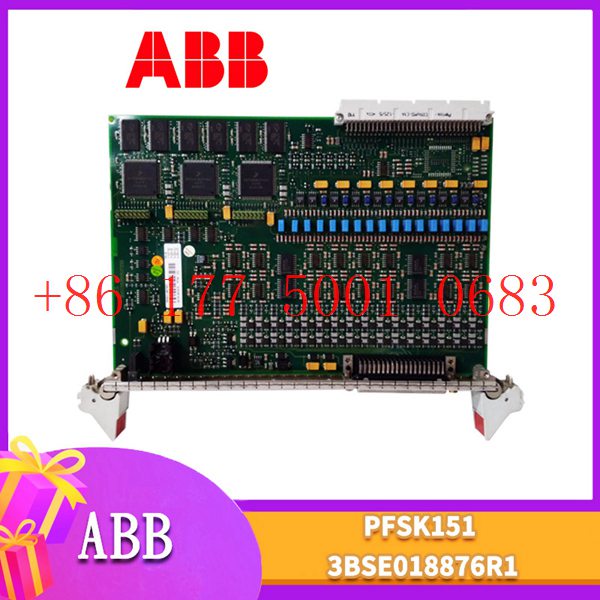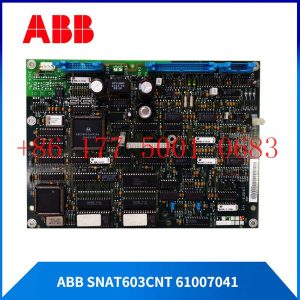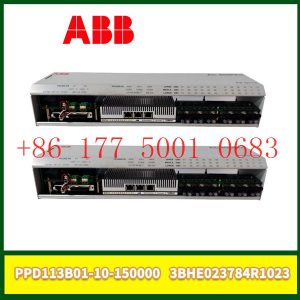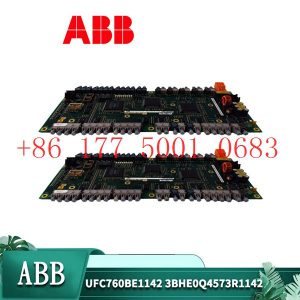Description
hardware flow control. It is an ideal choice in the field of industrial automation.
Implementation of communication between ABC industrial robot and PLC based on DeviceNet fieldbus technology
introduction
In modern production systems, industrial robots and PLCs need to communicate and collaborate to complete production tasks. That is, the
industrial robots output signals to the PLC, allowing the PLC to control related equipment to drive the robot”s front-end tools. This article
mainly analyzes the communication problems between ABB industrial robots and PLC based on DeviceNet fieldbus technology.
DeviceNet is a common network communication method in the field of automation. ABB industrial robots establish a network to communicate with
Siemens PLC based on the DeviceNet network.
1Configure DSQC652
There are mainly 5 types of standard I/0 boards commonly used in ABB industrial robots [2]. Except for the different addresses assigned to
them during setup, their configuration methods are basically the same. This article mainly analyzes the ABB standard I/0 board DS0C652, which
mainly builds communication modules based on the DeviceNet network. The DS0C652 board has a distributed I/O module with 16 digital input and 16
digital output interfaces. The board is installed in the ABB industrial robot control cabinet. First, define the specific operation steps of the DS0C652 board,
enter the teach pendant control panel, then enter the configuration menu (Figure 1), select the DeviceNetDevice menu, and add a template to enter Figure 2.
ABB standard I/0 board is hung on the DeviceNet
network, so the address of the module in the network must be set. The jumpers 6 to 12 of terminal x5 are used to determine the address of the module.
The available address range is 10 to 63. Modify the parameters in the template parameters to complete the DS0C652 board settings. Click the drop-down
menu to select the “Use value from template” row, select
“DS0C65224VDCI/0Device”, and then the parameters that need to be set include the address of the I/0 board in the bus.
Figure 1 Configuring DSQC652
2Configure signals and parameters
After completing the DS0C652 board setting, the I/0 signal setting will be performed. Setting the I/0 signal is the basis for establishing communication with
the PLC. The PLC communicates and transmits data with the ABB industrial robot through the I/0 signal and the DS0C652 board. As shown in Figure 3, in the
signal configuration interface, there are many default I/0 points after the system is established. Modification is not allowed. Click “Add” to add signals. When setting
input and output signals, their address range is 0~15. First, enter the signal menu in the configuration options to set the input and output types, and modify the corresponding parameters.
After completing the settings, the computer prompts that you need to restart the settings. If there are multiple signals that need to be defined and the waiting time
is long after restarting multiple times, you can click “Cancel” and wait for all signals to be defined before clicking the “Yes” button to restart. After the signal settings are
completed, click to select “Input and Output” in the ABB menu to check whether all signals have been set.
Figure 2 Configure DSQC652 parameters
Figure 3 Signal parameter settings
During the signal establishment process, attention should be paid to the DSoC652 port and PLC port addresses used, and the corresponding address table should be
established, as shown in Table 1. The robot interacts with the PLC through I/O signals. During the setting process, there must be no errors in the port and address number
of the PLC connected to the DSoC652. If the address is set incorrectly, the communication between the robot and the PLC will not work properly.
The entire robot teaching pendant setting process is shown in Figure 4.
Excitation system ABB module PPC322 HIEE300900R0001
Excitation system ABB module PPC222A02
Excitation system ABB module PPB022DE01 HIEE300867R0001
Excitation system ABB module PPA322B HIEE300016R2 HIEE400235R1
Excitation system ABB module PPA322B HIEE300016R2 HIEE400235R1
Excitation system ABB module PP886H 3BSE069297R1
Excitation system ABB module PP885 3BSE069276R1
Excitation system ABB module PP885
Excitation system ABB module PP883 3BSE092979R1
Excitation system ABB module PP881 3BSE092978R1
Excitation system ABB module PP881
Excitation system ABB module PP877K
Excitation system ABB module PP877 3BSE069272R2
Excitation system ABB module pp877 3bse069272r2
Excitation system ABB module PP877
Excitation system ABB module PP875 3BSE092977R1
Excitation system ABB module PP875
Excitation system ABB module PP874
Excitation system ABB module PP871
Excitation system ABB module PP865A 3BSE042236R2
Excitation system ABB module PP865A 3BSE042236R2
Excitation system ABB module PP865A
Excitation system ABB module PP865 3BSE042236R1
Excitation system ABB module PP865
Excitation system ABB module PP846A 3BSE042238R2
Excitation system ABB module PP846A 3BSE042238R2
Excitation system ABB module PP846A
Excitation system ABB module PP846A
Excitation system ABB module PP846 3BSE042238R1
Excitation system ABB module PP846 3BSE042238R1
Excitation system ABB module PP846
Excitation system ABB module PP846
Excitation system ABB module PP845A
Excitation system ABB module PP845 3BSE042235R1
Excitation system ABB module PP845 3BSE042235R1
Excitation system ABB module PP845
Excitation system ABB module PP845
Excitation system ABB module PP845
Excitation system ABB module PP836A
Excitation system ABB module PP836 3BSE042237R1
Excitation system ABB module PP836
Excitation system ABB module PP836
Excitation system ABB module PP835A 3BSE042234R2
Excitation system ABB module PP835A
Excitation system ABB module PP835
Excitation system ABB module PP835
Excitation system ABB module PP835
Excitation system ABB module PP826A
Excitation system ABB module PP826 3BSE042244R1
Excitation system ABB module PP826
Excitation system ABB module PP825A 3BSE042240R3
Excitation system ABB module PP825A
Excitation system ABB module PP825 3BSE042240R1
Excitation system ABB module PP825
Excitation system ABB module PP820
Excitation system ABB module PP815
Excitation system ABB module PP325 3BSC6901104R1
Excitation system ABB module PP245
Excitation system ABB module PP245
Excitation system ABB module PP220 3BSC690099R2
Excitation system ABB module PNI800
Excitation system ABB module PNI800
Excitation system ABB module PNI800
Excitation system ABB module PMKHRMRLY12S01
Excitation system ABB module PMKHRMPBA2000A
Excitation system ABB module PMKHRMPBA10003
Excitation system ABB module PMKHRMPBA10001
Excitation system ABB module PMKHRMPBA10






Reviews
There are no reviews yet.